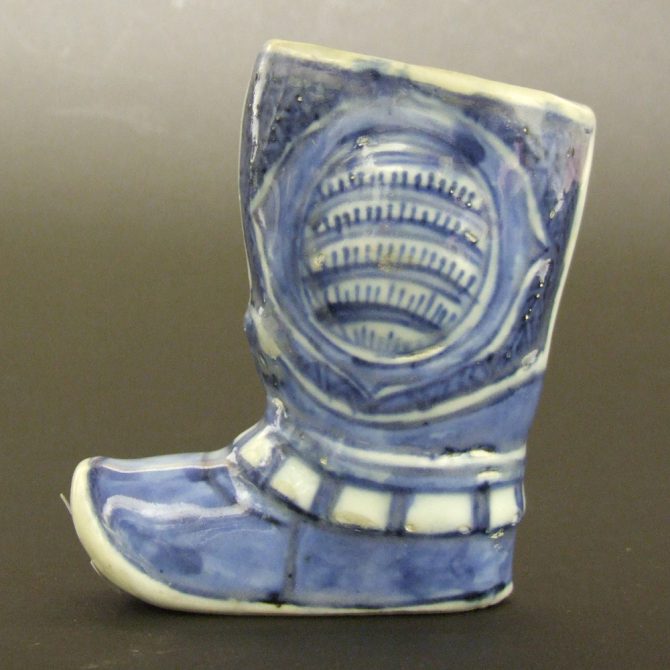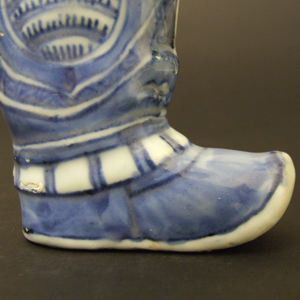
WANLI 1573 – 1620 Kraakware
A Very Rare Ming Blue and White Kraakware Porcelain Model of a Boot, Wanli Period 1573-1620. Booth Sides of the Boot Have What Appears to be Some Type of Armour, the Lower Upright Area Before the Foot is Gathered in Possibly Indicating Some Sort of Covering Over the Boot. Decorated in Typical Kraak Designs.
SOLD
- Condition
- The top rim, and toe of the boot with numerous filled chips, small glaze losses filled.
- Size
- Height : 9.6 cm (4 inches).
- Provenance
- R & G McPherson Antiques, stock number 16338. The John Drew Collection of Chinese and Japanese Ceramics, collection number 429.
- Stock number
- 23335
Information
We sold this Kraakware boot many years ago but were not able to find any references to it at the time. I have still not been able to find a kraak piece like it, or indeed any Ming blue and white model of a boot.
While know comparisons have been found a Fahua boot illustrated in Hobson in 1927 is now in the British Museum see : Catalogue of Late Yuan and Ming Ceramics in the British Museum.(Jessica Harrison-Hall.The British Museum Press, 2001. ISBN 0-7141-1488-X.) page 430, plate 13:42. Jessica Harrison-Hall states that the function of this object is not known but it could have been a water-pot for a scholars desk.
The John Drew Collection of Chinese and Japanese Ceramics, collection number 429.
John Drew was born in 1933 in Tideswell, Derbyshire, where his father was curate. The family moved to Norfolk whilst he was still a baby and his father became the rector of the parish of Intwood and Keswick. He was educated at Sedbergh School and after National Service in the R.A.F. being taught Russian, he went to Queens College, Oxford to read Greats (Classics). He spent nearly all his working life in various African countries as an archivist, moving to a post at Cape Town University in 1978. He remained in Cape Town after his retirement until his death in 2006. He had a great love of the English countryside (but not the climate) and this is shown in many of the pieces he collected. His taste was varied and ranged from Neolithic right through to the 18th Century. When we sent photograph to his home in Cape Town of pieces we thought he might be interested in, he would write long funny well observed letters back, wanting to add many of the items to his growing collection. Over the years we got to know him better and better, and during the last few years it was very rare for him to not want all the pieces we offered him. We knew his taste, even though his taste was so varied. This was in no small part because he had a very good eye and it was a pleasure finding things that interested him, because they were also very interesting to us. He never got to put his collection on display, something he hoped to do while on retirement in England, so it is with a mixture of pleasure and sadness that we offer these pieces from his collection. Each piece has a John Drew collection label, so when the collection is split up there will be some lasting record of the love and hard work he put into his two decades of collecting.
Kraakware / Kraak Porcelain :
Kraak Porcelain is a Type of Chinese Export Porcelain Produced from the Wanli period (1573-1620) until the end of the Ming Dynasty in the 1640`s. Kraak ware or Kraak porcelain was the first Chinese Export Ware to arrive in Europe in large quantities. Its name does not, as had been previously thought derived from the name of Portuguese trading ships, it is possible its name derived from Irish ships called Curachs. These trading ships worked between Ireland and England, they were know to the Dutch traders who used a similar word, craquen, to describe Portuguese trading ships. However in the 16th and early 17th centuries the word Kraak was not used in the V.O.C. record or inventories to describe porcelain. The first known time Kraak was first used as a term to describe a type of late Ming blue and white porcelain was in 1673. This was over 100 years after what we now know as Kraak porcelain was first produced, however there is some evidence that it was a term that had been in use for some time. Blue and white porcelain was exported to Europe in large quantities from the mid 16th century. It was highly prized and the Portuguese fort hard against the Dutch to keep control of this lucrative trade, but in 1602 the Dutch sold the cargo they captured from the Portuguese Carrack `San Tiago` and two years later they sold the cargo of the `Santa Catarina`. These ships caused a sensation, it was the first time such large amounts of Chinese blue and white porcelain had been available in Northern Europe, many of the pieces were `gifts` rather than to be sold on the open market . All Kraak porcelain was made at the main ceramic centre in China, Jingdezhen. It does vary in style and quality to quite a large extent, and some scholars include pieces as kraakware that others do not, so a definitive description is, I feel, rather difficult. The main group of kraak porcelain is less controversial. Normally thinly potted, often moulded, it`s designs are divided into decorative panels, with reserves that might include flowers and animals, taotie masks and stylised tulips. The bases often show `Chatter Marks`. These are ridges, that radiate from the centre of the base to the foot rim, they are caused by the potters finishing tool catching on the leather hard clay prior to glazing. When one looks at the construction, painting techniques and glazing of kraak porcelain it appears similar in many ways to some of the late Ming porcelain made for the Japanese market. I think it is quite possible that they were both made within the same kilns at Jingdezhen. Kraak porcelain also includes a few rare pieces that have the addition of underglaze copper red and there are a very few know examples of polychrome kraakware. Kraak porcelain went out of fashion at the end of the Ming Dynasty but was later revived during the reign of Kangxi (1662-1722). Swatow porcelain (c.1580-1640) was made in the kraak style but this is thicker and much cruder, the bases often show grit adhering.
